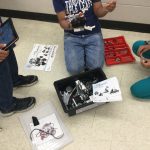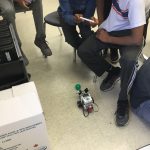Students with a mild intellectual disability (MID) regularly struggle with general literacy and numeracy skills which is a main contributor to their disengagement in the classroom. At Frank Oke Secondary School, where our student profile is primary students with an MID exceptionality, teachers struggle daily to engage students with meaningful and rich material. Additionally, the standards in which science is taught to this learning group throughout Ontario can vary greatly by school board. By using STEM, specifically Lego Robotics, this project will investigate its use to increase student engagement in the science classroom. Students will learn how to assemble various robot models and the basics of coding to accomplish specific tasks. Students will operate in teams and work collaboratively with their peers and teacher to solve any problems.
Much of today’s research focuses on STEM and its contribution to higher education and its eventual impact on the Canadian job market. However, there is little research focusing STEM’s impact on students with learning disabilities. This project focuses on a vulnerable student population who already face a great number of obstacles in the school system. Not only will this project teach valuable and transferrable skills, students can be in a learning environment that is engaging and accessible to their needs.
Team Members
Jonathan Leng
Toronto District School Board
Ann-Marie Jones
Toronto District School Board
Professional Learning Goals
- Used Lego Robotics EV3 in the science classroom in a classroom approach to teach problem-solving skills, collaboration, creativity and critical thinking skills
- Delivered a hands-on focused approach to students that allows all levels of learners to be successful by using the inquiry-based learning model
- Investigated how STEM-focused teaching affects a disengaged learner
Activities and Resources
- Integrate a new robotics program in the existing science curriculum taught at Frank Oke Secondary School
- Form thoughtful student groups to enhance the learning experience
- Give relevant background information on the application of robotics in today’s world
- Provide an inquiry-based learning environment where students encounter problems and learn to identify various approaches to a solution
- Provide students with a hands-on experience building robots and programming them on a computer
- Conduct daily feedback sessions to help elevate each group’s approaches and goals
- Engage the students by allowing them to determine their next steps
Unexpected Challenges
Working with students with a mild intellectual disability poses unexpected challenges when delivering an inquiry-based classroom activity. What makes inquiry so difficult with this population of students is that they can struggle with self-direction and independence. What is absolutely necessary is to provide additional scaffolding and support that will enable the students to be successful within the parameters of the given activity.
The team decided to give students a “practice” inquiry project that was unrelated to the EV3 project. This way, we can give a heavier hand in explanation, direction and execution, which would better support the students. We were able to identify areas where we would be sure the students would struggle with and give immediate feedback and direction.
Upon execution of the EV3 project, here are some challenges that we encountered:
- Students were very impatient to get started. It took some classroom management throughout the project to help redirect them.
- Although the student groups were made with care, group inquiries require co-operation and teamwork, which a few groups lacked. Some team building activities to help develop better communication and leadership were needed.
- The use of iPads in the programming took more time than we thought. Students were not adept to adapting to errors to correct the robot’s movement.
- Initially, we hoped to meet with students on a daily basis, but this proved to be unsustainable. Rather, we met student groups every three to four days, and focused on providing immediate feedback throughout the period.
- Lastly, translating the data of attendance, participation, performance and pre-post diagnostic into meaningful information to inform us on student engagement was a challenge.
Enhancing Student Learning and Development
By introducing transferrable and relative skills with hands-on inquiry-based approaches to these students, we can begin to narrow the learning gap and get the students excited to be in the classroom again. The challenges that face students with an MID exceptionality vary substantially. It can affect literacy and numeracy skills, non-verbal comprehension, reasoning skills, processing speed, working memory, and adaptive functioning. Because of these challenges, students with MID can easily be disengaged from the classroom. Our job in the classroom is not only to deliver meaningful curriculum, but to ensure the learning environment is accessible and engaging. This task is not always an easy one. Introducing new teaching strategies and new materials is essential to our teaching success.
The students at Frank Oke have tremendous strengths which this project will help enhance. The students are curious about the world around them, they shine in the face of adversity, they meet the teacher’s high expectations with tenacity and positivity, and their school experience can feel more like family than school. With this STEM-based project, we can help propel science teaching to a subject that reaches more students, engages more minds, and teaches skills that will be meaningful to the success of students with MID.
Sharing
Much of classroom robotics work is isolated to student groups and clubs. However, by investigating whether or not the integration of robotics in the science curriculum increases student engagement, we can begin bringing it into the classroom and directly into the hands of learners. This project will be piloted between two classes; one in the junior program and one in the senior program. With the completion of this project, I hope to expand the robotics program to all the science sections offered at Frank Oke Secondary School. This will involve working with additional science staff and having them brainstorm ideas of how to better deliver this program. I would also like to brainstorm how we can use robotics in our math and social studies courses.
Additionally, as the assistant curriculum leader of student support, I am in direct contact with many guidance counsellors and special education leads of the exceptional schools in the TDSB. I would like to share our success with our family of schools and encourage them to make use of STEM in their classrooms. Also sharing ideas and student experiences in a blog forum will enable us to network new ideas and reach educators beyond the Toronto District School Board.
Upon completion of this project, we will be presenting our project and results in the final school’s PLC via PowerPoint. Many teachers have already come into the classroom to see how the project is going and are excited to see the results. Some have already talked about executing a similar inquiry-based activity in their own classrooms. Also, we had four schools visit us via demonstration classrooms and were able to share our project with them.
Project Evaluation
The project was a success!
The overall goal of this project was to increase student engagement using STEM and inquiry-based strategies. Not only was the engagement noticeably higher through observation, but attendance and participation were marked considerably higher as well.
To use Lego Robotics EV3 in the science classroom to teach problem-solving skills, collaboration, creativity and critical thinking skills.
Three out of the four groups were able to fully complete their inquiry. These were the learning expectations for this project for the student’s IEPs:
1. Investigate the processes involved with an inquiry-based approach.
2. Build a functioning robot with at least two wheels and one sensor.
3. Explore programming the robot to complete three single-step tasks and at least two multi-step tasks using the iPad.
Success was determined using observation, student conferencing, completion checklists, demonstration of completion, and student report writing.
To deliver a hands-on focused approach to students that allows all levels of learners to be successful by using the inquiry-based learning model.
The classrooms where this project was executed were in a Mild Intellectual Disability Intensive Support Program. Students have a range of exceptionalities in this program which include: Mild Intellectual Disability, autism, physical disability, learning disability, and behaviour. Classroom work must be accessible to all learners and in this case, not only did the use of technology engage the students, but it played to many of their strengths which allowed them to be more successful than more traditional modes of learning.
Every student in the classes played some role in the inquiry projects. Some students who rarely participated in previous classroom tasks became group leaders, which was amazing to see. Here are some stats from our assessments:
- Attendance increased by 35 per cent over the course of the project
- Participation (completing work, answering questions, taking a role in a task, brainstorming in the group) increased by 140 per cent over the course of the project
- Student surveys indicated that 85 per cent of students gave this project a 10/10 for interest, 75 per cent of the students stated that they learned something that they can use in the future, and 100 per cent of the students stated they wanted to do this project again in their science class
If we were to execute this project differently, we would have:
- Spent more time preparing students for an inquiry-based activity
- Completed team-building exercises to foster group co-operation and communication
- Given students more time to explore the robot kits freely, without restriction
- Had smaller groups (two to three members instead of four to five)
- Used mentoring activities (for seasoned EV3 users) in future years
- Extended this project to after-school activity (but would require additional kids)
Resources Used
Robotics in the Classroom
http://www.learnersedgeinc.com/blog/robotics-in-the-classroom
Running a Robotics Classroom Checklist
http://www.education.rec.ri.cmu.edu/downloads/lego/get_started/classroom.pdf
Nall, Mark, Robotics in the classroom: The effectiveness of robotics based curriculum in STEM education. (2016). Graduate Research Papers. 88.
Faisal, Akim, AC 2012-5480: USING ROBOTICS TO PROMOTE LEARNING IN ELEMENTARY GRADES. (2012). American Society for Engineering Education. 1-14.
Resources Created
These resources will open in your browser in a new tab, or be downloaded to your computer.






